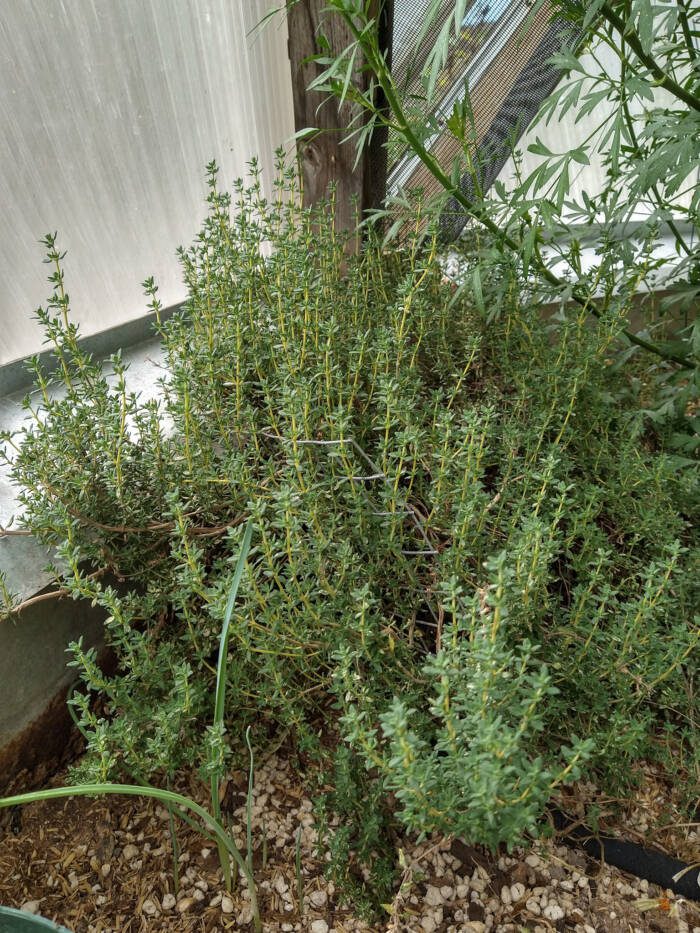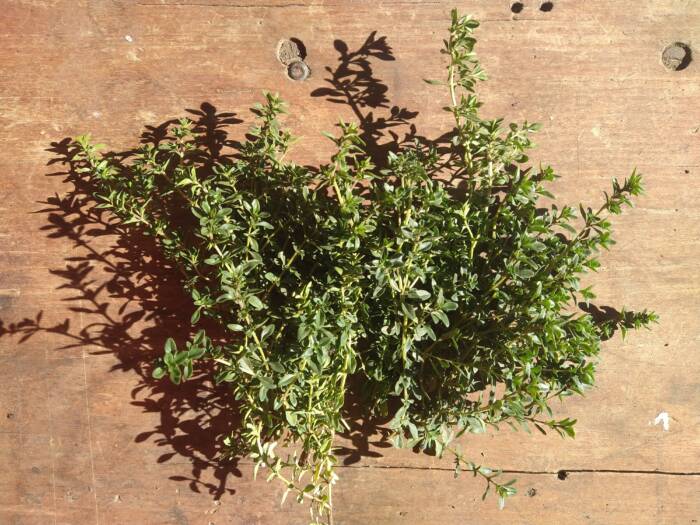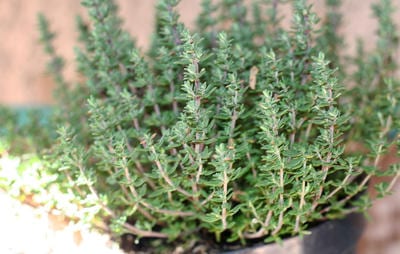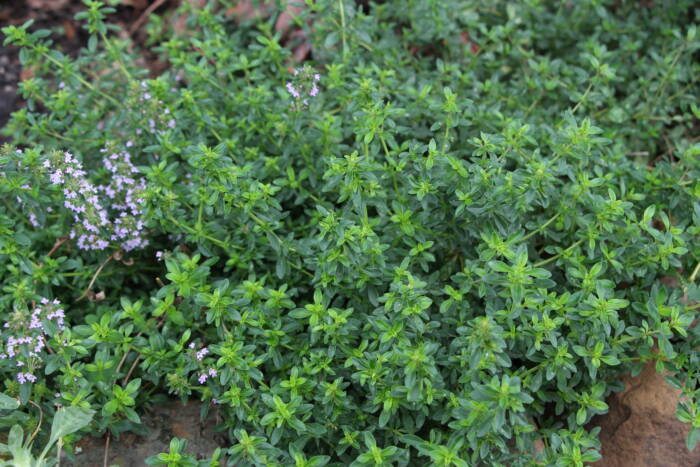
Jump to: The History of Thyme, Health Benefits of Thyme, How to Grow Thyme, Thyme Fun Facts, Thyme Companion Plants, When to Harvest Thyme.

Time to get growing thyme! Do you want to start growing thyme in your greenhouse? Thyme is a great herb to have right at your fingertips, year-round! Read more for tips on growing this herb in your greenhouse.
The History of Thyme: Know Before Growing Thyme
Thyme or Thymus vulgaris is from the family Lamiaceae and is native to the Mediterranean area. The first recorded use of thyme was in the first century AD. Sumerian cuneiform tablets (not our electronic kind) from 2750 BC show thyme being dried and ground with certain fruits and water for use as a poultice.
Thyme is an important her for both culinary and medicinal uses; in fact thyme was once used by the Egyptians in their embalming process. Romans used thyme on their floors to keep away venomous creatures and Benedictine monks used thyme in their elixirs as a health benefit.
The symbolism of thyme is courage; Roman soldiers bathed in thyme because they believed it would help them be courageous. Soldiers took thyme into battle to bostler their courage.
Health Benefits of Thyme
Thyme is full of health benefits along with its many uses in cooking. Thyme is very rich in nutrients, vitamins and minerals. It is particularly rich in vitamin A, an antioxidant, and vitamin C, which helps us resist infectious diseases. But that’s not all! Thyme contains B-complex vitamins, vitamin K, E and folic acid.

Thyme is a great source of minerals such as potassium, calcium, iron, manganese, magnesium and selenium. One little teaspoon of dried thyme will provide 10% of your iron requirements for a day. Thyme packs quite a punch in those little leaves! Greeks and Romans documented the use of thyme for its antiseptic properties and we still use it today for pulmonary illnesses such as coughs and colds. Benedictine monks used thyme in the elixirs they created due to it’s health benefits.
Growing Thyme
We have many choices available when it comes to growing thyme. What do we want in our greenhouse or garden? Flavored thymes such as lemon thyme or decorative species such as creeping thyme? Most culinary thyme is fresh or English variety. Although thyme grows in many regions around the world, it always needs dry, rocky soil.

One way to do that is to grow your thyme in a planter or pot rather than in a bed with other plants that have different watering needs. Another option is to plant your thyme in the warm, south facing bed and keep that soil stay drier than other areas of the bed as thyme is drought tolerant.
Many people prefer buying a thyme plant or starting with cuttings as growing thyme from seeds is a long process. If you do want to start thyme from seeds they should be planted 1/4″ deep and the plant will not be mature until it is two years old. Thyme grows to a width of 12-18″ and can grow between 5-12″ tall.
Thyme watering needs are very light. In fact if you water thyme too much it is susceptible to rot or mildew. Thyme prefers dry, well drained, rocky soil since it is drought tolerant.

Thyme Fun Facts for Growing Thyme
- Did you know that in Europe they tie “bouquet garni” (small bouquets) of thyme and other herbs together and add them to stews, sauces and soups. Remove the bouquets prior to eating the meal.
- When cooking in the Creole style, thyme is part of the technique of “blackening” meat and fish. Jamaican jerk seasoning also uses thyme.
- Plant Creeping thyme in place of lawns in hard to grow areas. It takes less water, spreads quickly and is soft yet durable. And it smells good!
- Thyme can help repel mosquitoes! Hooray for thyme!
- In Europe during the Middle Ages they placed thyme beneath the pillow to aid sleep and keep nightmares away.
- Burning thyme in your house can help get rid of insects.
Thyme Companion Plants
It’s “thyme” to learn more about companion planting with the amazing herb, thyme. One of the important things to consider in companion planting is water requirements. There are many plants that do well with thyme, but since thyme needs less water that has to be considered for all the plants thrive.
Some of the herbs that do well with thyme are rosemary, marjoram, sage and oregano. Thyme is also a great companion to strawberries as it makes a wonderful ground cover and helps to keep the soil moist for your strawberry plants.
Thyme acts as a deterrent to many different garden pests, but also attracts beneficial insects which helps their neighbors such as eggplant, potatoes, brassica crops, blueberries and tomatoes. Water wisely to keep thyme from getting to wet so you will keep your thyme dry and happy.
When is it Harvest “Thyme”?

This might be dating myself, but do any of you remember the Jim Croce song “Time in a Bottle”? The first line of the song is: If I could save time in a bottle….well you can! It’s best to harvest thyme just before the plant flowers and in the morning once the sun dries the dew. Harvest thyme by cutting off 5-6” of growth. If the leaves are clean, don’t wash them as it’s best to leave the essential oils on the leaves.

Remember to leave 5” of growth at a minimum so your thyme plant will still thrive. Dry thyme by hanging the sprigs in a dark, warm and well-ventilated room. After they dry you can store them in any airtight container, leaving them whole and crushing them right before you use them. They can retain flavor for up to two years if stored properly. Another method is to preserve thyme by freezing it. Lay the sprigs on parchment paper on a baking sheet. Once frozen transfer it to an airtight container and return it to the freezer.
Okay, I’ve taken up enough of your “thyme”, back to your greenhouse! Happy gardening!
Try our all “thyme” favorite thyme recipe Leftover Turkey Soup.

Join the Inner Circle
An exclusive place for year-round gardeners. Join us to receive our monthly newsletter, “The Happy Grower”. In our newsletter we provide community stories, event updates, expert gardening tips, and exclusive offers.
